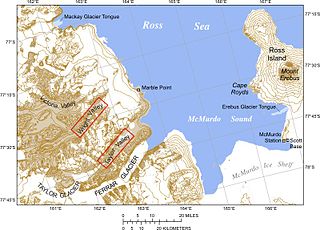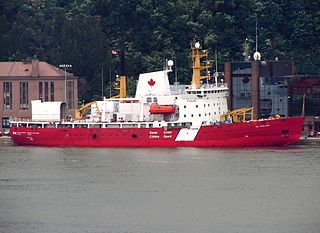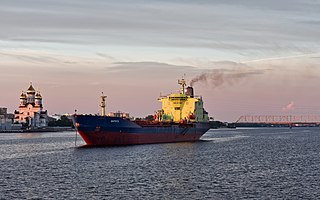
Seamanship is the art, knowledge and competence of operating a ship, boat or other craft on water. The Oxford Dictionary states that seamanship is "The skill, techniques, or practice of handling a ship or boat at sea."

The Northeast Passage is the shipping route between the Atlantic and Pacific Oceans, along the Arctic coasts of Norway and Russia. The western route through the islands of Canada is accordingly called the Northwest Passage (NWP).

An icebreaker is a special-purpose ship or boat designed to move and navigate through ice-covered waters, and provide safe waterways for other boats and ships. Although the term usually refers to ice-breaking ships, it may also refer to smaller vessels, such as the icebreaking boats that were once used on the canals of the United Kingdom.

A nuclear-powered icebreaker is an icebreaker with an onboard nuclear power plant that produces power for the vessel's propulsion system. Although more expensive to operate, nuclear-powered icebreakers provide a number of advantages over their diesel-powered counterparts, especially along the Northern Sea Route where heavy power demand associated with icebreaking, limited refueling infrastructure along the Siberian coast, and endurance required make diesel-powered icebreaker operations challenging. As of 2023, Russia is the only country that builds and operates nuclear-powered icebreakers, having built a number of such vessels to aid shipping along the Northern Sea Route and Russian arctic outposts since the Soviet era.

The Northern Sea Route (NSR) is a shipping route about 5,600 kilometres (3,500 mi) long, defined by Russian legislation as running from the entrances to the Novaya Zemlya straits in the west, along the Russian Arctic coast above Siberia through the Kara Sea, Laptev Sea, East Siberian Sea, and Chukchi Sea, to Cape Zhelaniya on the Bering Strait, at parallel 66 ° N and meridian of 168 ° 58′37 ″ W.

Drift ice, also called brash ice, is sea ice that is not attached to the shoreline or any other fixed object. Unlike fast ice, which is "fastened" to a fixed object, drift ice is carried along by winds and sea currents, hence its name. When drift ice is driven together into a large single mass, it is called pack ice. Wind and currents can pile up that ice to form ridges up to dozens of metres in thickness. These represent a challenge for icebreakers and offshore structures operating in cold oceans and seas.

The McMurdo Sound is a sound in Antarctica, known as the southernmost navigable body of water in the world, located approximately 1,300 kilometres (810 mi) from the South Pole.

The International Ice Patrol is an organization with the purpose of monitoring the presence of icebergs in the Atlantic and Arctic oceans and reporting their movements for safety purposes. It is operated by United States Coast Guard but is funded by the 13 nations interested in trans-Atlantic navigation. As of 2011 the governments contributing to the International Ice Patrol include Belgium, Canada, Denmark, Finland, France, Germany, Greece, Italy, Japan, the Netherlands, Norway, Panama, Poland, Spain, Sweden, the United Kingdom, and the United States.

CCGS Des Groseilliers is a Pierre Radisson-class icebreaker in the Canadian Coast Guard. The vessel is named after Médard Chouart des Groseilliers (1618–1669) a close associate of Pierre-Esprit Radisson in explorations west of the Great Lakes and the founding of the British Hudson's Bay Company. The ship entered service in 1982. The vessel has participated in a number of research voyages, including Ice Station SHEBA. As part of the Surface Heat Budget of the Arctic Ocean experiment conducted in the Arctic Ocean from October 1997 to October 1998 to provide polar input to global climate models, Des Groseilliers was allowed to be frozen into the ice for the Arctic winter, to serve as a base for scientific researchers.
Nautical publications is a technical term used in maritime circles describing a set of publications, either published by national governments or by commercial and professional organisations, for use in safe navigation of ships, boats, and similar vessels. Other publications might cover topics such as seamanship and cargo operations. In the UK, the United Kingdom Hydrographic Office, the Witherby Publishing Group and the Nautical Institute provide numerous navigational publications, including charts, publications on how to navigate and passage planning publications. In the US, publications are issued by the US government and US Coast Guard.

Ice class refers to a notation assigned by a classification society or a national authority to denote the additional level of strengthening as well as other arrangements that enable a ship to navigate through sea ice. Some ice classes also have requirements for the ice-going performance of the vessel.

Polar Class (PC) refers to the ice class assigned to a ship by a classification society based on the Unified Requirements for Polar Class Ships developed by the International Association of Classification Societies (IACS). Seven Polar Classes are defined in the rules, ranging from PC 1 for year-round operation in all polar waters to PC 7 for summer and autumn operation in thin first-year ice.

Fednav is a privately owned Canadian company in the maritime transport industry, involved in transporting over 30 million tonnes of bulk cargo and break bulk cargo worldwide. Its fleet comprises approximately 120 long-term and spot chartered vessels. The fleet includes most of St. Lawrence Seaway's maximum-sized bulk carriers, Supramax, and Panamax vessels.

MT Varzuga was an ice-strengthened product tanker that sailed under the Finnish flag in 1977–2003 and under the Russian flag in 2003–2021. After her modernization in 1993, she became the first merchant ship to be equipped with Azipod, an electric azimuthing propulsion unit developed in Finland in the late 1980s. She was also the first non-Soviet ship to transit the Northern Sea Route.
A Freezing Spray Advisory is issued by the National Weather Service of the United States to warn sea vessels and sometimes road vehicles near the shoreline that accumulation of freezing water droplets and icing due to a combination of cold suspended droplets, wind, and cold air, so vessel movement is possible, however, accumulations are not expected to reach rates of 2 cm per hour, or else a heavy freezing spray watch, warning or a specific notice would be issued.

Finnish-Swedish ice class is an ice class assigned to a vessel operating in first-year ice in the Baltic Sea and calling at Finnish or Swedish ports. Ships are divided into six ice classes based on requirements for hull structural design, engine output and performance in ice according to the regulations issued by the Finnish Transport and Communications Agency (Traficom) and the Swedish Maritime Administration.
The International Code for Ships Operating in Polar Waters or Polar Code is an international regime adopted by the International Maritime Organization (IMO) in 2014. The Code sets out regulations for shipping in the polar regions, principally relating to ice navigation and ship design. The international framework aims to protect the two polar regions — the Arctic and Antarctic, from maritime risks. The Code entered into force on 1 January 2017.
Robert LeMeur was an icebreaking platform supply vessel used to support oil exploration in the Beaufort Sea. Built in 1982 by Burrard Yarrows Corporation in Vancouver, British Columbia, she was part of the fleet of Canadian icebreakers, drillships and support vessels operated by Canadian Marine Drilling (Canmar), the drilling subsidiary of Dome Petroleum and later Amoco Canada Petroleum Company.

Ice navigation vessel or Ice-strengthened vessel is a class of ships specially prepared for independent ice navigation in the waters of the polar seas and for following icebreakers in especially difficult ice conditions. Various registration authorities assign ice classes to vessels based on their technical characteristics. Due to this, ice navigation vessels are usually referred to as ice-class vessels without indicating which class they belong to, but indicating the type of vessel.


















